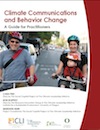Guidebook on climate communications and behavioral change
In order to motivate people to alter their views and behaviors related to global warming, leaders within all levels of government, the private sector, non-profits and communities must become aware of and utilize the fundamentals of effective climate communications, outreach, and behavioral change mechanisms.
To address this need, the Social Capital Project of the Climate Leadership Initiative — a social science-based research and technical assistance collaborative between The Resource Innovation Group and the Institute for a Sustainable Environment at the University of Oregon — has developed this guidebook, which draws on extensive global warming, behavior change and communications research completed by our organization and others as well as from practitioner expertise. The guide distills this information into tools and recommendations that climate leaders can easily apply. It includes talking points that have been tested with the public as well as quotes from focus group participants that reflect the attitudes of many Americans about global warming.
The guide is organized into two sections:
- Part One: The Role of Tension, Efficacy, and Benefits in the Global Warming Conversation
This section illustrates the challenges with existing climate communication efforts and provides tips on how to frame and deliver outreach efforts in a way that motivates changes in thinking and behavior.
- Part Two: Understanding and Connecting with Audiences
This section offers detailed advice and tips on how to frame global warming communications and promote behavior change in ways that resonate with a range of audience segments.




